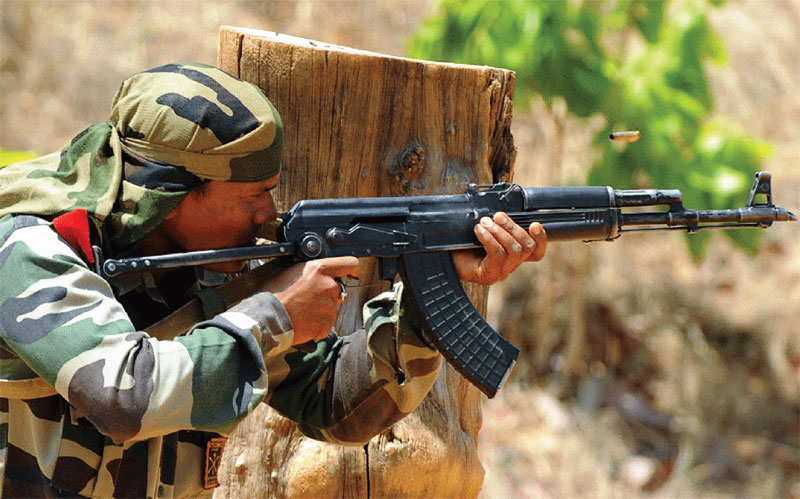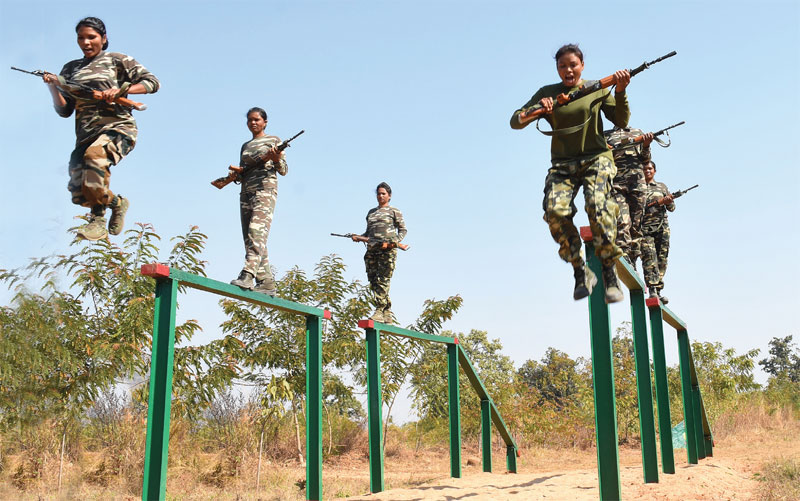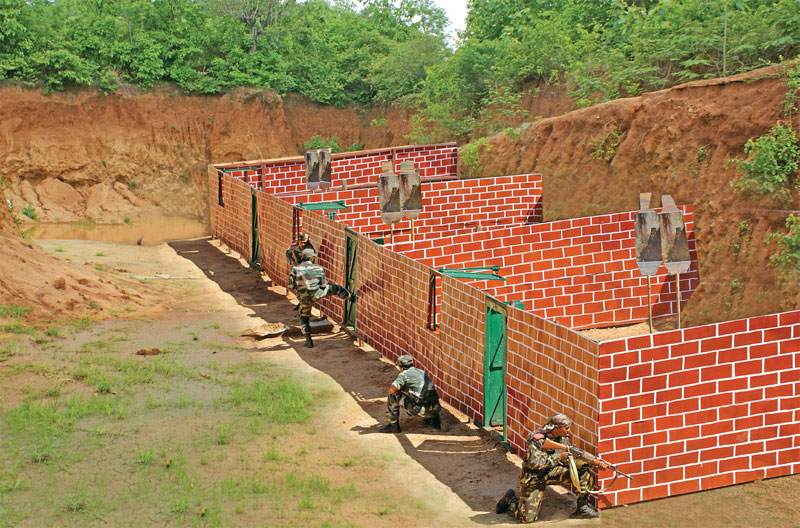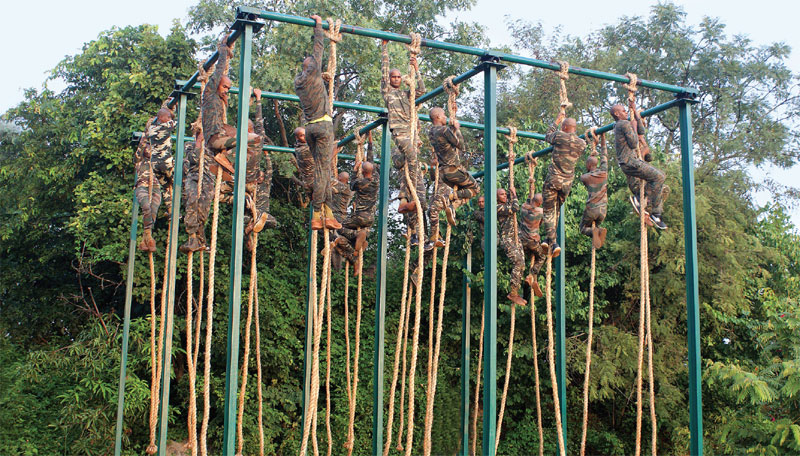Peace talks and capacity-building have to go together to tame the Maoists
Smruti D
Spring is one of the most beautiful seasons in India. While the duration of this season varies in different parts of the country, in most parts the months of February to March are regarded as Spring. April is the month of cruelty as it puts to sleep all the glorious blooms of Spring, ushering in the heat of summer.

This year, the cruelty of April was also announced in the forests of Chhattisgarh. On April 3, the combined team of CRPF and the state police walked into an ambush laid by the Maoists in the Bastar region of the state. 22 soldiers were killed; 31 were injured. One CoBRA commando of the CRPF was taken hostage, though subsequently he was released. The heat had begun.
The state of Chhattisgarh is among the poorest in India but sits on unimaginable reserves of natural wealth. In the heart of India, the state spreads over 135,191sqkm of area, of which, almost half is under forest cover (44.21 per cent). This pristine state with low hills, plateaus and plains is home to dense forests, inhabited by several indigenous tribes. While the river Mahanadi is the lifeline of Chhattisgarh, several other rivers like Indravati, Sabari, Leelagar, Hasdo, Pairi, Shivnath, Arpa and Sondur crisscross through this state. However, there are four catchment areas–Mahanadi, Ganga, Godavari and Narmada.
The natural resources of Chhattisgarh have made the state the battleground of conflicting interests. It is also the strongest bastion of the Communist Party of India (Maoist), also referred to as Left-Wing Extremists. As summer sets in, the Maoists, who are waging an armed insurgency against the Union of India (and run a parallel government of their own), launch their Tactical Counter Offensive Campaign (TCOC). Operationally, this is their most active period. They use TCOC to spread their reach, as well as to recruit new foot-soldiers and put them through their paces.
Speaking to FORCE on the condition of anonymity, a senior CRPF officer says, “Being the residents of the forests, Naxals launch the TCOC in this period because they understand the terrain and know that the humidity of the forest reduces the efficiency levels of the security forces as they are not acclimatized to this weather. They know that the personnel get exhausted when they return from long range patrol and their energy levels dip. Obviously, this impacts their alertness too.”
Hence, the Naxals are able to mount successful attacks. The fallen leaves because of the weather also works to their advantage. “While the visibility becomes high, the sound of leaves crushing under the shoes of the soldiers gives away their movement. Add to this the humidity, which makes walking even small distances tiring, forcing the security forces to take multiple halts. They also need a lot of water to keep themselves hydrated, which forces them to engage with the locals,” he says, adding that this is the primary reason why it appears that the security forces repeat the same mistakes all over again.
This is what happened on April 3 as well. The gun battle broke out when the security forces were returning after an anti-Naxal operations. More than 2,000 personnel from five camps in Sukma and Bijapur, comprising CRPF’s Commando Battalion for Resolute Action (CoBRA), District Reserve Guards (DRG) and the Special Task Force (STF) had gone into the forest around Tarrem in Bijapur district on a combing mission. While they were on their way back, the Naxals ambushed them.
A similar incident had happened last year too. In March 2020, the security forces and the Maoists had an encounter in the Chintagufa area of Sukma district. A total of 17 soldiers belonging to the joint security team were killed. Both attacks were carried out by the PLGA commander Madvi Hidma. In April 2017, a Maoist ambush in Burkapal in Sukma district killed 25 CRPF jawans. This year, just before the April incident, five policemen were killed and 13 were injured as Naxals blew up a bus in Chhattisgarh. The landmine explosion happened between Kanhargaon and Kadenar villages under the Dhaudai police station limits in the state’s Narayanpur district.
In each attack, the pattern remains the same. According to Special DGP, Chhattisgarh Police, R.K. Vij, “The security forces had gone for an intelligence-based operation near Tekulgudem of Sukma. When the Maoists attacked suddenly, the security personnel took position and retaliated. Some Maoists got killed in the exchange of fire but we also suffered casualties. Instead of calling this operation a failure, one needs to understand the professional hazards of operating in a hilly and forested terrain. The Maoists lay ambushes and use IEDs, which the security forces cannot do. However, we need to learn from each incident and improve upon our tactics to minimize the loss on our side.”

The case of Chhattisgarh is special as it remains the stronghold of the Maoists. After Andhra Pradesh police’s Greyhounds chased the Maoists away, the beleaguered group found a safe place in Chhattisgarh. Today, the majority of Naxals are the tribespeople from Chhattisgarh. As mentioned earlier, the conflicting interests of the government, which wants to exploit the natural resources to fuel the national economy and the tribes, which regard them as their natural wealth, ensures that the Maoists are not short of volunteers who wish to take to arms against the State.
The second reason for Maoists’ sway in Chhattisgarh is the topography of the state. The Bastar region, subdivided into seven smaller districts of Kanker, Narayanpur, Kondagaon, Bijapur, Dantewada, Jagdalpur and Sukma, sprawls over nearly 40,000sqkm, of which nearly 15,000sqkm is under the control of the Maoists. The security personnel have not been able to penetrate this area. This region also has, what are the ‘base areas’ that are devoid of security camps or police stations, enabling the Maoists to move around unobstructed, taking advantage of this security vacuum.
Says Vij, “The terrain of Bastar is a big challenge in itself for the security forces. It gives an advantage to the Maoists to lay ambushes and hide their identity. Therefore, even if operations are well planned, the force may be taken by surprise at times. The security forces need to be as alert as a bird.”
The location of Bastar helps Maoists slip into neighbouring states of Odisha and Maharashtra, whenever they find themselves cornered. After the latest incident, chief minister Chhattisgarh, Bhupesh Baghel said that this was the first time the soldiers entered into the Maoists’ bastion which made them retaliate in such a manner. He added that Naxalism will be uprooted completely from the state.
As compared to the previous decades, the area that the Maoists held has shrunk. Hence, they have been resorting to different strategies to enhance their capabilities in terms of technology. Today, they possess state-of-the-art rifles, rocket launchers and improvised explosive devices. Only recently, in March, a Naxal weapons manufacturing unit was destroyed along the Maharashtra-Chhattisgarh border in an interstate operation led by the C-60 commando unit of Gadchiroli police.
Even though the security personnel do possess latest weapon systems, the gap is in real time intelligence. After every incident, the government sets up internal inquiries. However, none of this brings about any change in the way security personnel operate. Intelligence failure, lack of higher-level leadership on the ground, lack of cohesion between the forces, failure in following the Standard Operating Procedure (SOP) and poor planning in terms of deployment of huge forces are some of the factors which are held up as causes of poor performance.
Sparks of Hope
The situation in Bastar, however, seems to have improved since 2003, when there were only three battalions of the CRPF. Today, the number hovers around 50, including other central armed police forces.
According to director, Counter Terrorism and Jungle Warfare College, Brig. B.K. Ponwar, “Police personnel get killed when they let down their guard. Those who got killed were not trained in my college. Those people are trained locally by giving some training and weaponry. What I believe went wrong in this operation was that they shouldn’t have entered a village. We are not supposed to enter a village in a Naxal area. We have to maintain higher heights and be very careful of the return journey. Different route must be taken. The incident happened because they weren’t following the rules of warfare and leadership. Not because of lack of capabilities. Leadership aspect needs reconditioning, which is why operations go wrong.”
Guerrilla warfare implies hitting the stronger army at their weaker points. Earlier, the forces did not know how to locate an IED. Many of the personnel died because of the IED blasts. Now, IED warfare has been taught to them. In Chhattisgarh, over 150 IEDS used to be triggered in a year. Today, the number has been brought down just 15-20 a year with hardly any casualties.
Adds Vij, “We have not only increased in numbers but have also improved in quality. We have one specialised Counter Terrorism and Jungle Warfare (CTJW) School in Kanker and four Counter Insurgency and Anti-Terrorism (CIAT) Schools in Chhattisgarh that train the security personnel. The state government has also increased our armed battalions from seven to 22. However, we still have to occupy more areas which has security vacuum.”
The forces, by increasing their presence and numbers through deployment of joint forces, has led to a commendable change. The space that the Maoists held in the states has shrunk. As Maoists are short of cartridges, they tend to loot arms and ammunition of the forces. Currently, as per the latest data put out by the ministry of home affairs (MHA), Naxals are present only in 11 states and 90 districts. All officer, serving and retired agree that there is no dearth of weapon systems with the security personnel. In terms of capacity-building, the security forces have also been given state-of-art weapon systems such AK-47, light machine guns, rocket launchers and the under barrel grenade launcher. A certain number of UAVs and night-vision devices, as well as helicopters have also been allocated for counter LWE operations.
For countering the IEDs, which remains the most prominent of all threats in the area, the security forces have been equipped with Deep Search Mine Detectors (DSMDs) and Non-Linear Junction Detectors (NLJDs). Many IEDs are detected directly by the security personnel through careful survey of the area. However, this still remains an area of challenge as many IEDs go undetected. The Maoists currently use wooden and iron spikes and snipers.
In 2019, security forces deployed in the anti-Naxal combat grid launched a massive operation to detect and defuse IEDs, as over 260 troops had either been killed or injured in these blasts. The Maoists resort to the use of IEDs to offset their depleting combat strength.

In terms of personnel strength, the Director General, CRPF told FORCE that they were not looking to induct anymore battalions to fight LWE. Only recently, CRPF inducted women CoBRA personnel. However, these women have not yet been deployed alongside the men in fighting the Naxals. A police officer in one of the districts of Chhattisgarh said that women troops are still undergoing training and will be deployed thereafter.
Another source that FORCE spoke with said that women are not taken on overnight operations in the forests. They are also not allowed to go more than five to 10 km inside the forest. Even women from state police forces return to their camps at dusk, despite the fact, that women soldiers from the Bastaria battalion are said to be performing very well. One of the officers, who requested anonymity, says that he had personally deployed women soldiers to interact with the villagers. According to him, local women soldiers do make it easier to get the information from the villagers as the latter tend to open up to them.
Analysts often point out the hybrid nature of force composition in most operations. While most officers that FORCE spoke with, say that there are no major issues of communication and cooperation, certain smaller issues crop up from time to time. “Every force has its own ethos. They work on their own principles. However, every state police wants to take the credit for themselves. Even though the CRPF performs alongside them, they are not given the credit. In Punjab we fought the militancy, but the credit went to the Punjab police, because policing is a state subject and we have no say in it. I personally feel that some part of internal security and policing should be included in the Concurrent list. This should be a part of the federal subject.”
On being asked how this will help, he says, “The CRPF is sent to assist the state police. This restricts us from carrying out independent operations, despite being the lead force for internal security. We need a legal framework to plan and carry out independent operations. That’s how you fix accountability.”
Training
After stepping up the Counter Insurgency (COIN) efforts, government of India established a number of Counter Insurgency and Anti-Terrorist Schools in some of the most-affected states in India. Chhattisgarh has four schools at Chandkuri, Jagdalpur, Rajanandgaon and Bilaspur. Chhattisgarh also has the College of Counter Terrorism and Jungle Warfare at Kanker, headed by Brig. Basant Kumar Ponwar.
In 2004, the governor of Chhattisgarh, Lt Gen. K M Seth proposed setting up this college to train the state police in counter-Maoist tactics. Until then, about 100 police personnel from Chhattisgarh used to train at Indian Army’s Counter Insurgency and Jungle Warfare (CIJW) school in Vairengte in Mizoram. Ponwar was the Commandant there. Upon superannuating from there, he was invited to set up a similar institution in Chhattisgarh.
Ponwar says that in a traditional set-up, a policeman’s role begins only when an FIR is lodged. Counter-Naxal operations are a different ballgame, he says. According to him, “The Naxals won’t come to lodge an FIR. They will come to overrun the police station, kill all the policemen and take away their weapons. For this purpose, we need a security ring of about 15-20km around the police station to get the information.” He says that the aim of his school was to convert the policeman into a warrior, a counter-Naxal operative.
“I was called by the Chhattisgarh government to set up a training establishment that would convert the law and order oriented police force into a combat force. The first course started from 22 August 2005, and since then over 36,000 personnel have gone through the college. The curriculum consists of 45 days of rigorous commando training,” he says. The early courses started with only the Chhattisgarh police. Subsequently, police personnel from states such as Odisha, Jharkhand, Bihar and West Bengal also started to come in. After the Chintalnar incident of 6 April 2010, when 76 soldiers of the CRPF were killed by Maoists, a battalion of the CRPF too underwent training in the college.
Brig. Ponwar lives by the philosophy that he teaches his students to fight a guerrilla like a guerrilla. “Since Naxals can live in the jungle, we must know how to live in a jungle, in all weather conditions and amidst animals, reptiles and insects,” he says.
The college campus is sprawled across 800 acres of land. It has 17 firing ranges, a gymnasium, an endurance track, an advance obstacle course, rock-climbing and helicopter slithering area. It has artificial lakes, which are used for water crossing training. The cadets are taught rules of warfare, road opening and tactics for return journey after a patrol.

Of all the challenges faced by the security forces, intelligence remains one of the biggest. With the local population being the centre of gravity, the forces carry out civic action programmes to keep the villagers on their side. However, as senior police officers accept, the local people are the worst sufferers. They are stuck between a rock and a hard place. Being local and armed, the Naxals try to dominate the civilians. The security forces’ outreach only make the locals more vulnerable, as they get marked as police informers.
Eventually, the military approach can only deliver this much. Real resolution can only come through talks. Says sociologist Nandini Sundar, “There has never been a serious attempt at talks. Talks doesn’t mean you ask the other side to lay down arms and only then you will talk. Because then, what is there to talk about? There are so many instances in the world where people start with confidence-building agenda. Laying down of arms is always the last thing that is done. Demobilisation is one of the elements of the conclusion of the agreements. It cannot be the pre-condition. There was only one serious attempt at talks in Andhra Pradesh in 2004 but eventually even that turned out to be dishonest.”
Until the government starts the process of talks in real earnest, the forests of central India will continue to throw up unpleasant surprises.
History in a Box
The earliest roots of LWE can be traced to the Telangana peasant rebellion in 1946-51. Thereafter the peasants of West Bengal rebelled against farm laws in 1967 in a village called Naxalbari, which lend the movement its name. Despite the ruthless crushing of the movement by the state government, the idea of Naxalbari thrived and inspired other such protests. It also drew in idealist youth from all over the country. Since then the ‘armed revolution’ by the ‘have-nots’ has spread across the country.
At one point, when the movement was at its peak, more than 200 districts were affected by it. In 2006, Prime Minister Manmohan Singh had called it the ‘greatest internal security threat’. A few years later, in 2011, home minister P. Chidambaram echoed the sentiment by saying that India faced multiple security threats, Left Wing Extremism was the biggest one. He had even gone to the extent of saying that LWE was an even graver threat than terrorism.

